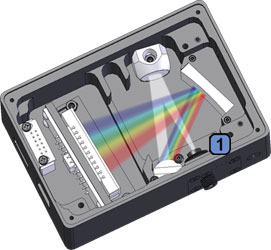Part 1: The Slit
Overview
 A spectrometer is an imaging system which maps a plurality of monochromatic images of the entrance slit onto the detector plane. This slit is critical to the spectrometer’s performance and determines the amount of light (photon flux) that enters the optical bench and is a driving force when determining the spectral resolution. Other factors are grating, groove frequency and detector pixel size.
A spectrometer is an imaging system which maps a plurality of monochromatic images of the entrance slit onto the detector plane. This slit is critical to the spectrometer’s performance and determines the amount of light (photon flux) that enters the optical bench and is a driving force when determining the spectral resolution. Other factors are grating, groove frequency and detector pixel size.
The optical resolution and throughput of a spectrometer will ultimately be determined by the installed slit. Light entering the optical bench of a spectrometer via a fiber or lens is focused onto the pre-mounted and aligned slit. The slit controls the angle of the light which enters the optical bench.
Slit widths come in a number of different sizes from 5µm to as large as 800µm with a 1mm (standard) to 2mm height. It is important to select the right slit for your application since they are aligned and permanently mounted into a spectrometer and should only be changed by a trained technician.
The most common slits used in spectrometers are 10, 25, 50, 100 and 200 μm. For systems where optical fibers are used for input light coupling, a fiber bundle matched with the shape of the entrance slit (stacked fiber) may help increase the coupling efficiency and system throughput.
Technical Details
The function of the entrance slit is to define a clear-cut object for the optical bench. The size (width (Ws) and height (Hs)) of the entrance slit is one of the main factors that affect the throughput of the spectrograph. The image width of the entrance slit is a key factor in determining the spectral resolution of the spectrometer when it is greater than the pixel width of the detector array. Both the throughput and resolution of the system should be balanced by selecting a proper entrance slit width.
The image width of the entrance slit (Wi) can be estimated as:
Wi = (M2×Ws2+Wo2)1/2
Where M is the magnification of the optical bench set by the ratio of the focal length of the focusing mirror (lens) to the collimating mirror (lens), Ws is the width of the entrance slit, and Wo is the image broadening caused by the optical bench. For a CZ optical bench, Wo is on the order of a few tens of microns. So reducing the width of the entrance slit below this value won’t help much on improving the resolution of the system. The axial transmissive optical bench provides much smaller Wo. Thus it can achieve a much higher spectral resolution. Another limit on spectral resolution is set by the pixel width (Wp) of the array detector. Reducing Wi below Wp won’t help to increase resolution of the spectrometer.
Under the condition that the resolution requirement is satisfied, the slit width should be as wide as possible to improve the throughput of the spectrograph.
Browse our extensive line of spectrometers.
Submit your questions using the “Request Quote or Info” button above, or call us at (855) MY-BWTEK.







